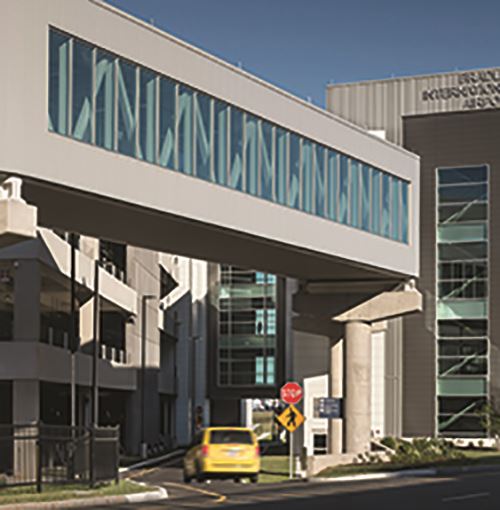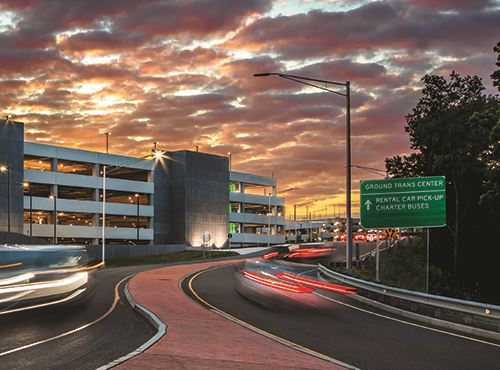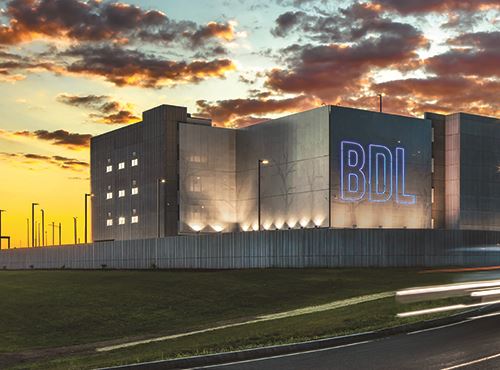This summer, Bradley International Airport (BDL) in Windsor Locks, CT, opened a new rental car facility and ground transportation center that spans 13.4 acres and includes 1.5 million square feet of space in three buildings: a five-story ready/return garage, a five-story quick turnaround facility and a four-story vertical circulation building. The entire facility is connected to the terminal by an elevated, covered pedestrian bridge and features the airport’s three-letter identifier, BDL, in bright lights.
This summer, Bradley International Airport (BDL) in Windsor Locks, CT, opened a new rental car facility and ground transportation center that spans 13.4 acres and includes 1.5 million square feet of space in three buildings: a five-story ready/return garage, a five-story quick turnaround facility and a four-story vertical circulation building. The entire facility is connected to the terminal by an elevated, covered pedestrian bridge and features the airport’s three-letter identifier, BDL, in bright lights.
 The ground level of the new facility contains public parking and provides space for future connection to public ground transportation. Level one is owned and operated by the Connecticut Airport Authority, which operates BDL and five general aviation airfields throughout the state. Levels two through five house leased customer service facilities and operational support for nine car rental brands.
The ground level of the new facility contains public parking and provides space for future connection to public ground transportation. Level one is owned and operated by the Connecticut Airport Authority, which operates BDL and five general aviation airfields throughout the state. Levels two through five house leased customer service facilities and operational support for nine car rental brands.
Roots for the project reach back to 2015, when the Airport Authority included a consolidated rental car center in its master plan update. Previously, BDL had a patchwork of surface lots, which required rental car companies to operate individual buses between the terminals and rental car service areas. Bob Bruno, director of Planning, Engineering and Environmental for the Connecticut Airport Authority, explains that consolidating rental car facilities at BDL has improved the customer experience and relieved curbside congestion by eliminating associated shuttle operations.
|
Project: New Ground Transportation Center Location: Bradley Int’l Airport — Windsor Locks, CT Facility Size: 13.4 acres; 1.5 million sq. ft. Cost: $210 million Funding: Customer facility charge revenues Construction: Aug. 2019–June 2022 Total Labor Hours: 574,169 Key Components: Car rental facility; additional public parking; future public transportation access Rental Car Operators: Avis, Enterprise Holdings & Hertz plus their affiliates Developer: Conrac Solutions Design-Build Partner: Austin Commercial Architect: PGAL Local Construction Partner: KBE Building Corp. Program Manager: WSP Mechanical & Electrical Engineering, Plumbing, Telecommunications, Security: Burns Engineering Civil Engineering: Urban Engineers Precast Concrete Supplier & Installer: Blakeslee Prestress Inc. Fire Protection: Wolverine Fire Protection Co. Code Consulting: Jensen Hughes Structural Engineering: Walter P Moore Fueling & Quick Turnaround Area Systems Engineer: Stantec Construction Inspections: Terracon |
The $210 million project was financed entirely through customer facility charge revenue. The new facility is located west of the main terminal on what previously had been a surface lot for public parking. The project included a new surface public parking lot to replace much-needed public parking at BDL.
A covered open-truss pedestrian bridge that crosses over the roadway used by vehicles dropping off and picking up passengers connects to a conditioned pedestrian walkway, which connects the new ground transportation center to the terminal. Project executives note that building a consolidated car rental center within walkable distance from the terminal improves the passenger experience by removing shuttle bus traffic from the primary airport roads/curbside areas and reducing associated vehicle emissions. They estimate the new facility will eliminate more than 250,000 shuttle trips per year—and are confident that customers won’t miss the shuttle rides.
Partners Involved
The rental car companies operating at BDL partnered with Conrac Solutions for a development contract, which included project development, design and construction. WSP was selected as the program manager for the Airport Authority and assisted from planning and design through construction completion. Conrac Solutions secured contracts with Austin Commercial as the design-build partner and PGAL as the architect.
KBE Building Corp., the prime subcontractor to Austin, served as the local construction partner and provided connections to area trade contractors. More than 800 crewmembers worked on the construction project from August 2019 into June 2022.
The majority of contractors hired were local to the New England area. Although there was no mandatory minority business participation requirement, about 28% of the contract was comprised of companies hired by Austin and KBE that were small, minority- and women-owned businesses.
Updated Design
The new facility includes nearly 2,800 rental car spaces, nine car washes, 36 fueling positions and more than 50 electric vehicle charging stations. Floors two through four house individual rental car facilities, with one brand family per floor. The fifth floor (roof level) is shared rental car storage.
Mike Minerva, chief executive officer of Conrac Solutions, explains that this distributed customer service model focuses on efficiency and customer experience, providing better access to rental car brands on multiple floors while saving space that is usually needed for large, open lobbies. “That’s an innovation that really will improve the experience and improve the efficiency and the use of valuable airport real estate,” says Minerva.
Because most passengers arrive at BDL’s car rental center with pre-booked reservations, they can cross the pedestrian bridge and head directly to the appropriate brand within the multi-level building via escalators and elevators with appropriate signage.
Design trends have changed significantly over the years, evolving to smaller customer service buildings inside rather than large, consolidated outside service facilities. “They’re more compact now and more user-friendly to the rental car companies and passengers,” notes Kelly Locke, vice president of Austin Commercial’s National Aviation Division. “[BDL’s] is the most modern and mature design of this kind of facility.”
 One standout feature is the stacked nature of three vital components—the distributed customer service building, ready/return areas, and quick turn-around areas for fleet washing, vacuuming and fueling—all allocated to each floor. “By designing the facility in this manner, it optimizes operational efficiency and eliminates the potential for unused space,” says Joshua Blum, vice president of Real Estate and Concessions at Hertz. The design eliminates building lobby space, which reduces costs and allows each rental car company to create its own customer service space on its floor. “The BDL consolidated facility is a hallmark of what the latest generation of ConRACs should be,” Blum remarks.
One standout feature is the stacked nature of three vital components—the distributed customer service building, ready/return areas, and quick turn-around areas for fleet washing, vacuuming and fueling—all allocated to each floor. “By designing the facility in this manner, it optimizes operational efficiency and eliminates the potential for unused space,” says Joshua Blum, vice president of Real Estate and Concessions at Hertz. The design eliminates building lobby space, which reduces costs and allows each rental car company to create its own customer service space on its floor. “The BDL consolidated facility is a hallmark of what the latest generation of ConRACs should be,” Blum remarks.
This distributed customer service model will also be used at the new consolidated rental car facility at Reno Tahoe International, which is scheduled to be complete in 2026.
 At BDL, the new rental car center is located in a confined area surrounded by roadways and an existing garage. The main vehicle entry and exit had to be strategically located to minimize curbside traffic congestion at the terminal but also to facilitate quick exits from the facility, notes Camille Bechara, vice president/senior director of Transportation Facilities and Aviation, New England district leader, for WSP.
At BDL, the new rental car center is located in a confined area surrounded by roadways and an existing garage. The main vehicle entry and exit had to be strategically located to minimize curbside traffic congestion at the terminal but also to facilitate quick exits from the facility, notes Camille Bechara, vice president/senior director of Transportation Facilities and Aviation, New England district leader, for WSP.
Accommodating electric vehicles in rental fleets was an emerging need that arose while the project was already under way. (For more details about how the airport and its design team adjusted, see Page 36.)
Operational Areas
Most of the space in the new ground transportation center is devoted to rental car operations: the customer service building, ready/return areas and three levels of quick turnaround areas with fueling stations, vacuums, car washes and maintenance bays.
 The quick turnaround garage contains many improvements compared to BDL’s former facilities. “It is much more sustainable, much cleaner, much more environmentally friendly because everything is done to very specific environmental and safety standards for servicing the rental car fleets at the airport,” remarks PGAL Executive Vice President Jeff Weiner.
The quick turnaround garage contains many improvements compared to BDL’s former facilities. “It is much more sustainable, much cleaner, much more environmentally friendly because everything is done to very specific environmental and safety standards for servicing the rental car fleets at the airport,” remarks PGAL Executive Vice President Jeff Weiner.
Project designers separated the ready/return areas from the quick turnaround facilities but connected them to customer service areas to enhance efficiency for the rental car companies. “The footprint the airport provided and the design that we worked out with our partners from the airport really make that work very well,” Minerva says.
For convenience, fuel pumps are located in the quick-turn areas on levels two, three and four. This atypical arrangement required the above-grade fuel lines that run below the garage decks to be enclosed in special assemblies for fire protection.

Mixed-Use Components
The first level of the new facility includes 830 additional public parking spaces, increasing BDL’s total parking capacity by 10%. Half of the new spaces are covered parking; half are in a surface lot next to the ground transportation center. Eventually, the airport plans to convert the surface lot into a parking garage and tie it into the existing circulation for public parking.
During planning for the new ground transportation center, the team identified the need to relocate the egress points and toll booth plaza for the adjacent public parking garage. That work occurred while the design-build team finalized construction drawings for the new facility, notes Shaun St. Lawrence, senior project manager with KBE Building Corp.
 An area on the ground level of the vertical core building is earmarked for connections to public transportation, including high-frequency bus services and, eventually, the nearby Windsor Locks rail line. “We provided a perimeter corridor to set that location within the footprint of our facility to allow future buildout of that overhead rail or rail grade potential,” notes PGAL Senior Associate Ryan Townson.
An area on the ground level of the vertical core building is earmarked for connections to public transportation, including high-frequency bus services and, eventually, the nearby Windsor Locks rail line. “We provided a perimeter corridor to set that location within the footprint of our facility to allow future buildout of that overhead rail or rail grade potential,” notes PGAL Senior Associate Ryan Townson.
Construction Wins
Early in the design-build planning process, the project team determined it could save more than 12 months by prefabricating the garages’ precast concrete components off-site and bringing them to the project site using just-in-time delivery.
The team worked closely with Blakeslee Prestress Inc., a Connecticut-based precast supplier, throughout the process. “Heavy emphasis was placed on integrating the precast with the planned building systems, which in turn helped speed construction once the precast was delivered to the site,” says St. Lawrence.
This prefab approach for the garages also helped ensure rigorous quality control, St. Lawrence adds. Individual components included oversight by a state-mandated third-party inspector who reviewed the precast fabrication at the supplier’s plant, Blakeslee’s own quality control process and additional reviews by Austin Commercial’s quality control team.
Construction was able to proceed more efficiently than originally planned thanks to significant decreases in passenger traffic during erection due to the pandemic. Crews completed roadway work and utility connections while traffic was unusually low at the airport.

No environmental mitigation was needed for the ground transportation center project because that was taken care of during an enabling project the Airport Authority completed. The state’s Department of Transportation managed the initial infrastructure work for a roadway realignment project before turning the site over to the Airport Authority for the new ground transportation center. “The only remaining mitigation work needed was demolition and removal of the original vehicle bridge, which dated back to the initial airport construction,” St. Lawrence explains. “Our remediation work also included removal of the lead paint on the steel bridgework.”
Coordinating FAA permits for crane usage was a key driver of the planning and scheduling process. KBE started the application during the design phase, and Blakeslee developed a plan detailing the 20+ crane locations, with a schedule for each location. Minimal changes to the erection plan were needed, thanks to the expedited schedule driven by pandemic-related decreases in passenger traffic. St. Lawrence notes that the crane permitting process can typically take four months or longer. This project received needed approvals in within three months of final application and allowed the team to start precast erection in May 2020.
Federal and state OSHA personnel selected the project for an OSHA Safety Training Partnership—KBE’s seventh such effort, St. Lawrence notes. “KBE, OSHA and CONN-OSHA combined forces to set a standard that will inspire construction companies around the country to voluntarily take steps to improve their own safety practices, instead of waiting for the government to get involved when a situation becomes too dangerous,” he explains.
Sustainability Efforts and Benefits
Although the design-build team did not seek LEED certification for this project, it met all local and state sustainability requirements. “We’re seeing that more and more,” Locke comments. “Cities and municipalities adopt sustainability requirements in their codes that amount to the same building that would be LEED accredited.”
Beyond the elimination of shuttle buses and the addition of EV chargers, the project added behind-the-scenes sustainability measures as well. Rental companies use environmentally friendly products to wash their vehicles while 85% of the water used is reclaimed from previous cycles. “Sustainability is always at the forefront of what we incorporate into our designs,” Townson remarks. “Water is reclaimed after each wash cycle, cleaned through a series of settling tanks, then reused in subsequent cycles to produce clean cars for the renting customers.”
The design team further reduced water usage by specifying efficient toilets and low-flow, aerated faucets in the restrooms. Within the parking garages, PGAL used natural light harvesting, durable LED fixtures and motion sensors to reduce ongoing energy requirements. The airport received an incentive for the project from its local energy provider, Eversource, for installing LED lights and high-efficiency HVAC systems.
The facility also includes an energy-efficient wall design to reduce the temperature fluctuations of interior spaces, St. Lawrence adds. Plasma air purifying equipment cleans the air with bipolar ionization to help remove airborne bacteria and viruses.

Challenges and Opportunities
Constructing 1.5 million square feet of space on a 20-acre jobsite was no small undertaking. The process of installing 3,000 drilled aggregate piers to provide a suitable substrate for the foundations alone took 11 months. “Coordinating the just-in-time delivery of the precast was a feat in itself,” says St. Lawrence.
Another challenge was a significant slope at the southwest end of the building—almost 20 feet from high to low. Crews had to consider the elevation change throughout site planning, design and foundation work. PGAL took advantage of the slope by lowering the facility, incorporating traffic signage and using that area as the primary entrance from the adjacent roadway near a new landscaped roundabout.
Because the new ground transportation center was public-private development, it allowed for a fast-track process, with design and the start of construction occurring at the same time, Bechara notes. “That meant providing adequate direction to the design team, having them submit design documents on time and reviewing them as quickly as possible so the construction could start as soon as possible,” he explains.
 Naturally, COVID added its share of challenges, but design and planning consultants followed precautions to continue working. Some created shift schedules, rotating employees between home and the office when possible. “We had to put measures in place to make sure that we didn’t lose our critical people from being sick,” Locke says.
Naturally, COVID added its share of challenges, but design and planning consultants followed precautions to continue working. Some created shift schedules, rotating employees between home and the office when possible. “We had to put measures in place to make sure that we didn’t lose our critical people from being sick,” Locke says.
The construction team kept inspections by state building officials on schedule by using video conference walk-throughs to show key areas of work. “The state agencies agreed [to the virtual method], and we were able to obtain the needed reviews and approvals,” says St. Lawrence.
With passenger traffic in a major downturn, the airport’s main terminal road was only lightly used. “This provided an advantage to the design-build team and offered the ideal conditions to construct the connector bridge over the main terminal road,” St. Lawrence adds. “It would have been far more difficult to complete that work pre-pandemic.”
Lessons Learned
For other airports considering similar projects, Bruno suggests fostering strong communication between the design team and rental car agencies. He also stresses the importance of wayfinding signage. “You do the best you can, and then realize people just do different things when they get to an airport,” he remarks. “So you have to make some minor changes.”
Stakeholder engagement is key, Blum agrees. “One of the most important aspects of the process to build this facility was the willingness of the project stakeholders to look at all aspects of the rental car experience at BDL and design a solution that corrects all of the pain points rental car customers historically had to endure,” he relates.
 Minerva emphasizes the need to engage car rental companies to make gains in customer service and vehicle turn around. “I think we’ve come up with something together that passengers and all the airport stakeholders are very happy with,” he remarks.
Minerva emphasizes the need to engage car rental companies to make gains in customer service and vehicle turn around. “I think we’ve come up with something together that passengers and all the airport stakeholders are very happy with,” he remarks.
Bechara advises including rental companies in preliminary phases of the development process, because they will occupy, operate and maintain their spaces. “Planning and designing such a facility without their early involvement would lead to several changes, delays in schedule and potentially cost increases,” he reasons.
Weiner notes that it’s important to develop facilities according to traffic forecasts and the airport’s master plan. He also stresses the benefits of applying past experiences from other projects to continually improve sustainability, maintainability and constructability. “It takes a huge team, a huge effort to pull all that together,” Weiner says. “Consensus building is critical and making decisions early on, and sticking with them, is probably the key to a successful project in an ever-changing airport environment.”
Locke recommends carefully thinking through how traffic flows to and from this type of building—how that impacts current facilities, the potential to displace traffic and people in parking facilities, etc. “You need lots of early planning and testing to make sure that there are no critical flaws in your plan,” he cautions.
Townson highlights the advantage of building a multi-use facility, like BDL’s. “It incorporates public parking, ground transportation features, along with rental car needs, and mixes it all right at the doorstep of the terminal,” he explains. “It’s walkable, expandable and built into the master plan to expand and change with the airport’s needs.”
St. Lawrence says the design-build delivery method saved time by bringing design and trade contractors together with the client from the onset. “For example, the team was able to identify early on the need for the ‘make-ready’ work of relocating the egress points for the existing garage. And that work got underway while the design was still developing and designing the main project,” he explains. Having the precast subcontractor and the mechanical, electrical and plumbing trades work hand-in-hand with the design engineers was also beneficial.
“I’d estimate that this project, if delivered in a traditional state design-bid-build process, would have taken eight to 10 years to complete,” St. Lawrence remarks. “We turned it over in three years from the issuance of the formal notice to proceed with design and construction.”
Working with seasoned partners, some with airport experience and others with local knowledge, also proved helpful, St. Lawrence adds.
Looking Ahead
As this year draws to a close, BDL is preparing to undertake two additional large infrastructure projects. The first will add two small extensions on either end of the terminal to improve passenger circulation. Currently, all passengers use one checkpoint, which is also where the exit is. The new extensions will allow passengers to come out of the concourse and exit at the end of the facility.
The second project is a four-story building with an inline checked bag screening system on the first level. The second level will have space for future gates and holdrooms, and the third level will be a mezzanine. When this new building is complete, the Airport Authority will remove all bag screening machines from BDL’s main terminal.
|
Charging Forward The new consolidated rental car facility at Bradley International Airport (BDL) straddled a pivotal line in the advancement and use of electric vehicles. When design criteria were developed for the project in 2017, electric vehicles had not achieved critical mass. But that changed as the project progressed, and BDL reacted accordingly. Hertz aims to have electric vehicles comprise 30% of its global fleet by 2024. “We want to be a leader in EV adoption and the overall reduction in reliance on internal combustion vehicles,” says Joshua Blum, the company’s vice president of Real Estate and Concessions. The facility at BDL, completed this summer, included 29 electric vehicle chargers upon opening, with additional charger installation in design and construction for the rental car operators’ new electric vehicles. The airport plans to have a total of 60 chargers installed by the end of the year. Charging equipment is spread throughout the three rental/return levels of the new building. Accommodating the evolving auto technology was not simply a matter of adding chargers. Contractors had to distribute power through the new facility for such equipment. The biggest issue, however, was ensuring sufficient electrical capacity. Mike Minerva, chief executive officer of Conrac Solutions, notes that BDL and the project team worked with local utility providers to increase the incoming electrical service that serves the new facility.
Chuck Dennie, project manager with Burns Engineering, notes that the iterative design-build process required design to progress aggressively to achieve construction milestones. Constraints such as the guaranteed maximum price and long lead times to procure key components prevented the design team from reevaluating the original approach regarding electric vehicle chargers before construction began in 2019. “Because the subcontractors were bidding on design documents that were at the 60% level, everyone was progressing with a degree of design assumption until the equipment was actually procured,” Dennie explains. “This style of project delivery requires a flexible design that avoids overly specialized equipment whenever possible. As the project unfolded, spare natural gas and electrical capacity eroded as mechanical equipment, accent lighting and tenant space loads increased. However, with a growing national focus on electrification, the project team had the forethought to build in additional electrical capacity for future use.” Last year, rental car companies began to fit out the base building with their specific layouts, branding and operations. “At this point, the emergence of electric vehicles as an eventual successor to internal combustion was evident,” recalls Dennie. That’s when the challenge of incorporating EV chargers into the project really began. Beyond ensuring overall electrical capacity, engineers worked to minimize the reduction of parking spaces to accommodate distribution equipment and to install conduit inconspicuously. Power management was employed within the charger controls to optimize charger output to electric vehicles with the greatest need, or to throttle consumption during peak periods. Dennie says that 53 chargers will satisfy the near-term needs of BDL’s rental car companies, but Burns continues to study options for increased electric service to support he eventual need for more chargers. “As battery designs become more advanced, charger technology will continue to improve in an effort to shorten charging times,” he adds. “It is important to consider both increases in quantity and increases in consumption when planning for the next wave of chargers.” Burns emphasizes the need for rental car companies to match local demand for electric vehicles, and for airports to provide the needed power on demand. “Unlike airport passenger parking, this means that rental vehicles are out on the road the majority of the day and that returned vehicles must be charged and ready as soon as feasible,” Dennie relates. “The strategy employed at Bradley includes utilizing a low diversity factor to ensure there is no bottleneck of energy transfer even during peak charging periods.” |


 facts&figures
facts&figures



